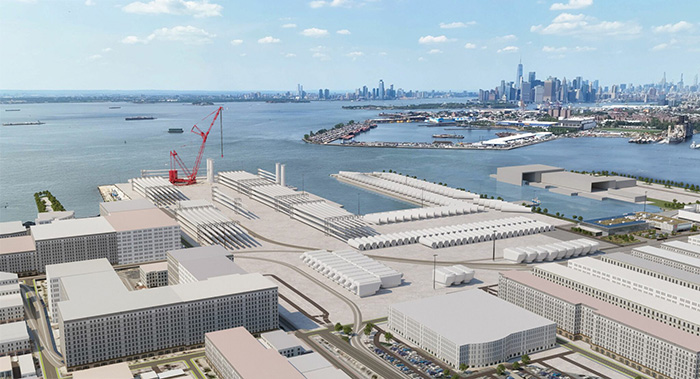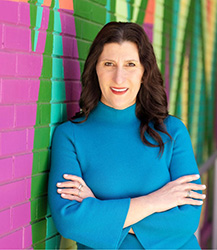Volume 28 | Issue 2
By Jennifer Brown, Senior Vice President, Portfolio Management, New York City Economic Development Corporation (NYCEDC)
Click here to read the complete illustrated article or continue below to read the text article.
Several historic properties along the South Brooklyn waterfront are currently undergoing a meaningful, generational transformation—a sweeping, long-term reinvention of infrastructure, purpose, and opportunity. This transformation isn’t just about redeveloping aging buildings – it’s about reimagining how 200 acres of this waterfront district can serve the next century of innovation, equity, and economic growth.
With over $2 billion in public and private investment, NYCEDC is spearheading the transformation of Sunset Park’s historic infrastructure into the campuses of the future, launching the next generation of this working waterfront. Both the Brooklyn Army Terminal (BAT) and MADE Bush Terminal—along with the South Brooklyn Marine Terminal (SBMT) and the Brooklyn Wholesale Meat Market—are sites of access and opportunity that feel truly limitless in potential.
This isn’t a collection of isolated projects. It’s a cohesive, district-wide, sustained effort grounded in a few key priorities: innovation, opportunity and community. The Sunset Park District supports people in many ways—whether they’re entrepreneurs launching new businesses, residents from the surrounding neighborhood and throughout Brooklyn finding meaningful jobs close to home, or neighbors coming together to connect.
NYCEDC’s work is guided by a triple bottom line philosophy—creating and sustaining spaces for people while ensuring long-term prosperity. That means supporting equitable workforce development, investing in green infrastructure to reduce emissions, and enabling economic resilience by attracting innovative industries and entrepreneurs.
This is about turning Sunset Park into a national model for urban development. Through business development, thoughtful community programming and large and small-scale public realm enhancements, NYCEDC is opening up these assets to businesses and reconnecting people to the waterfront. These sites are being reborn— honoring their history, but forging them ahead as models for the future.
The Sunset Park District’s transformation is a cornerstone of Mayor Eric Adams’ “Harbor of the Future” initiative, which integrates clean energy, advanced manufacturing, and public access and is currently home to over 130 businesses employing upwards of 4,000 people.
This transformation is creating lasting connections between people, places, and opportunity. We’re not just opening doors to new industries, we’re opening up the waterfront to the community, making it alive with possibility. The Sunset Park District now stands as a powerful example of how thoughtful investment can bridge the past and future—while putting people at the center of it all.
Originally constructed in 1919, the Terminal was, the nation’s largest military supply base during World War II, and has undergone a remarkable transformation. The 59-acre, 4.1 million-square-foot industrial campus now under NYCEDC’s stewardship exemplifies the agency’s commitment to generational transformation. NYCEDC is investing in this 106-year-old campus, not just to preserve its legacy, but to reimagine it as the campus of tomorrow.
Over the past decade, more than $500 million has been invested to modernize the terminal. This includes the introduction of new leasable space, enhanced infrastructure, campus-wide improvements, and enhanced public realm, all designed to support local jobs and sustainable economic growth.
BAT’s tenants range from industrial and food manufacturers to wood workers and beyond, including: world-famous chocolatier Jacques Torres, The Konery, Norwegian Baked, MOMO dressing, Green Mustache, MakerSpace NYC, Rooftop Films, ArtBuilt, technology manufacturer Altronix, retailer Uncommon Goods, nonprofit fabric recycling center FABSCRAP, and the New York Embroidery Studio.
A centerpiece of the renaissance of BAT will be BATWorks. A consortium led by the Los Angeles Cleantech Incubator (LACI) and the Cambridge Innovation Center (CIC) will design and operate BATWorks, a cutting-edge climate innovation hub. The world-class BATWorks hub will provide start-ups with space for product research and development, as well as offer workforce training and job placement programming to New Yorkers. NYCEDC’s $100 million investment in BATWorks will help create over 600 jobs, serve 150 startups over 10 years, and generate $2.6 billion in economic impact for the city.
Last December, the Adams administration, UPROSE, and Working Power announced the development of Sunset Park Solar to bring clean, reliable, and affordable solar energy to Sunset Park residents and businesses. The 725 kilowatt (kW) solar array at BAT will reduce greenhouse gas emissions, alleviate energy burdens, and protect low-income households from energy price fluctuations. Currently under construction, the project will deliver $1.24 million in energy bill savings to approximately 150 households over its lifetime.
The Brooklyn Wholesale Meat Market comprises over 200,000 square feet dedicated to food processing, cold storage, and distribution. It serves as a hub for wholesale businesses working across meat, poultry, fish, and produce, playing a vital role in the region’s food supply chain. The market is currently operating at full capacity, reflecting strong demand for this type of infrastructure in New York City.

Located less than a mile from BAT is the 36-acre MADE Bush Terminal – an acronym for Manufacturers, Artisans, Designers, and Entrepreneurs. This campus is being repurposed as a hub for innovative manufacturing, design, and small business growth. Historically a bustling shipping center employing approximately 35,000 people in the early 20th century, MADE Bush Terminal consists of eight buildings adjacent to the waterfront. What makes MADE particularly unique is its ground-up repositioning, a systemic redevelopment of each building to ensure a cohesive, multi-faceted campus that reconnects the community with the waterfront.
The recently opened Building A at MADE offers 140,000 square feet of leasable manufacturing space for industrial businesses and artisans, along with 30,000 square feet dedicated to public events and community space. Surrounding the building are five acres of landscaped public space, featuring plazas, pedestrian pathways, and an emphasis on future waterfront connections.
Looking ahead to Summer 2025, NYCEDC will break ground on the transformation of the long-defunct Pier 6 into a five-acre waterfront park. This project will provide recreational space with scenic views of Lower Manhattan and Governors Island advancing NYCEDC’s goal to integrate industrial redevelopment with vibrant, inclusive public spaces.
An additional $38 million has been invested to transform Bush Terminal Park into a vital green space reconnecting the Sunset Park neighborhood to the waterfront. The park features scenic views of tidal pools and the Bay Ridge Channel, plus a multi-sport field, comfort station, bike lanes, and walking paths. This investment is a commitment to accessible, sustainable public space and makes the park a model for equitable waterfront revitalization.
Adjacent to these revitalization efforts is the South Brooklyn Marine Terminal (SBMT), one of the most significant renewable energy infrastructure projects in the country. Currently under construction across 75 acres, SBMT is poised to become one of the largest offshore wind port facilities in the nation. The site is being transformed through a $107 million capital investment from the City, alongside more than $1 billion in private funding. The project is expected to create over 1,000 construction jobs, catalyzing economic activity and workforce development in the region. Once completed, SBMT will support the staging, assembly, and deployment of offshore wind components, ultimately delivering clean energy to over 500,000 homes and businesses.
Through strategic investments, public-private partnerships, and a focus on sustainability and equity, NYCEDC is creating a future where New Yorkers can thrive along a world-class, innovative, working waterfront. Sunset Park is more than an industrial zone; it is a living model for purposeful economic development, sustainability, and long-term community investment.

About the Author:
Jennifer Brown is the Senior Vice President of Portfolio Management at New York City Economic Development Corporation (NYCEDC). A mission-driven public sector and nonprofit executive, she is committed to advancing the economic growth and vitality of New York City’s neighborhoods, businesses, public spaces, and institutions. Jennifer brings to NYCEDC extensive experience in community and economic development, placemaking, and public-private partnerships. She is a proven leader in program development, organizational strategy, stakeholder engagement, and external affairs, with a track record of building and mentoring high-performing, cross-functional teams. Her work is rooted in strengthening communities through inclusive development and innovative initiatives.
In this episode, I sat down with Beejan Giga, Director | Partner and Caleb Emerson, Senior Results Manager at Carpedia International. We discussed the insights behind their recent Industry Today article, “Thinking Three Moves Ahead” and together we explored how manufacturers can plan more strategically, align with their suppliers, and build the operational discipline needed to support intentional, sustainable growth. It was a conversation packed with practical perspectives on navigating a fast-changing industry landscape.